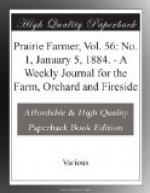MULCHING AND MANURING.
Mr. Earle was questioned about the use of castor bean pomace for strawberries. He uses it mixed with wood ashes. It is capital on poor land. He likes unleached ashes in both strawberry and orchard culture. He pays six cents per bushel for them. The castor bean pomace is good for anything in the poor soils of Southern Illinois. He uses about half a ton to the acre. Spreads with a Kemp spreader. Five hundred pounds per acre will show excellent results. Has tried a tablespoonful of the mixture to the strawberry plant when setting out. Has tried salt to kill grubs in asparagus beds, but found it to kill the weeds and most of the asparagus, while the grubs seemed to enjoy the application. Did not find it of much value as a manure. Bone dust had shown no particular results. Superphosphates acted much like the bean pomace. Does not think coal ashes of much value. He uses the pomace as early in the spring as possible. Sometimes he plows it under and sometimes applies after the plants are set, and cultivates it in. One application answers for two years’ cropping. He fruits a strawberry plantation but two years, and he sometimes thinks one year sufficient. He does not agree with some of his neighbors that mulching has resulted unfavorably. Does not think the mulch has increased the noxious insects. Knows of a plantation not mulched at all, that suffered more than any other this year from the tarnished plant bug.
CENTRAL DISTRICTS.
Mr. Vickroy reported for Central Illinois. In August of the present year he visited the orchards in the vicinity of Champaign, among them the noted Hall fruit farm, near Savoy. He found the orchards in fair condition. Many were sheltered by belts of trees. He observed that in the lower or bottom land he found in connection with drainage, the best orchards and the healthiest trees, and that on the more rolling or higher grounds the trees were not as hardy nor did not bear as well. His observations led him to believe in the draining of orchards, although it was opposed to his previous education and of the teachings he had received in this society. He regarded the experimental orchard which he visited at Champaign a failure, for the very reason that it was on too high ground; that the trees were dying, and many were not bearing. There were, however, some varieties that showed good fruit. In his visit referred to, he found the following varieties of apples did well in this latitude:




